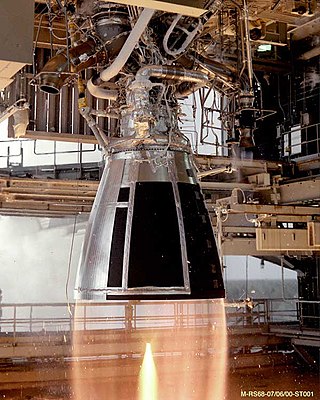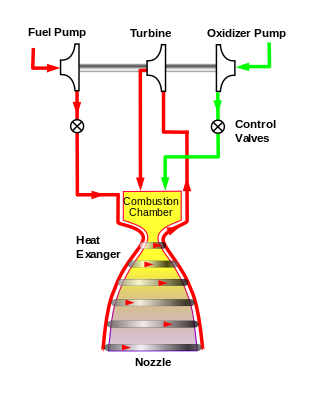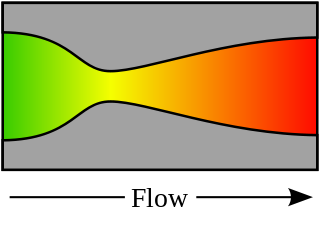Related Research Articles

Interplanetary spaceflight or interplanetary travel is the crewed or uncrewed travel between stars and planets, usually within a single planetary system. In practice, spaceflights of this type are confined to travel between the planets of the Solar System. Uncrewed space probes have flown to all the observed planets in the Solar System as well as to dwarf planets Pluto and Ceres, and several asteroids. Orbiters and landers return more information than fly-by missions. Crewed flights have landed on the Moon and have been planned, from time to time, for Mars, Venus and Mercury. While many scientists appreciate the knowledge value that uncrewed flights provide, the value of crewed missions is more controversial. Science fiction writers propose a number of benefits, including the mining of asteroids, access to solar power, and room for colonization in the event of an Earth catastrophe.

A rocket is a vehicle that uses jet propulsion to accelerate without using any surrounding air. A rocket engine produces thrust by reaction to exhaust expelled at high speed. Rocket engines work entirely from propellant carried within the vehicle; therefore a rocket can fly in the vacuum of space. Rockets work more efficiently in a vacuum and incur a loss of thrust due to the opposing pressure of the atmosphere.

A ramjet is a form of airbreathing jet engine that requires forward motion of the engine to provide air for combustion. Ramjets work most efficiently at supersonic speeds around Mach 3 and can operate up to Mach 6.

A steam engine is a heat engine that performs mechanical work using steam as its working fluid. The steam engine uses the force produced by steam pressure to push a piston back and forth inside a cylinder. This pushing force can be transformed, by a connecting rod and crank, into rotational force for work. The term "steam engine" is most commonly applied to reciprocating engines as just described, although some authorities have also referred to the steam turbine and devices such as Hero's aeolipile as "steam engines". The essential feature of steam engines is that they are external combustion engines, where the working fluid is separated from the combustion products. The ideal thermodynamic cycle used to analyze this process is called the Rankine cycle. In general usage, the term steam engine can refer to either complete steam plants, such as railway steam locomotives and portable engines, or may refer to the piston or turbine machinery alone, as in the beam engine and stationary steam engine.

Spacecraft propulsion is any method used to accelerate spacecraft and artificial satellites. In-space propulsion exclusively deals with propulsion systems used in the vacuum of space and should not be confused with space launch or atmospheric entry.

A nuclear thermal rocket (NTR) is a type of thermal rocket where the heat from a nuclear reaction replaces the chemical energy of the propellants in a chemical rocket. In an NTR, a working fluid, usually liquid hydrogen, is heated to a high temperature in a nuclear reactor and then expands through a rocket nozzle to create thrust. The external nuclear heat source theoretically allows a higher effective exhaust velocity and is expected to double or triple payload capacity compared to chemical propellants that store energy internally.
The nuclear salt-water rocket (NSWR) is a theoretical type of nuclear thermal rocket designed by Robert Zubrin. In place of traditional chemical propellant, such as that in a chemical rocket, the rocket would be fueled by salts of plutonium or 20-percent-enriched uranium. The solution would be contained in a bundle of pipes coated in boron carbide. Through a combination of the coating and space between the pipes, the contents would not reach critical mass until the solution is pumped into a reaction chamber, thus reaching a critical mass, and being expelled through a nozzle to generate thrust.

The aerospike engine is a type of rocket engine that maintains its aerodynamic efficiency across a wide range of altitudes. It belongs to the class of altitude compensating nozzle engines. Aerospike engines were proposed for many single-stage-to-orbit (SSTO) designs. They were a contender for the Space Shuttle main engine. However, as of 2023 no such engine was in commercial production, although some large-scale aerospikes were in testing phases.

A rocket engine uses stored rocket propellants as the reaction mass for forming a high-speed propulsive jet of fluid, usually high-temperature gas. Rocket engines are reaction engines, producing thrust by ejecting mass rearward, in accordance with Newton's third law. Most rocket engines use the combustion of reactive chemicals to supply the necessary energy, but non-combusting forms such as cold gas thrusters and nuclear thermal rockets also exist. Vehicles propelled by rocket engines are commonly used by ballistic missiles and rockets. Rocket vehicles carry their own oxidiser, unlike most combustion engines, so rocket engines can be used in a vacuum to propel spacecraft and ballistic missiles.

The expander cycle is a power cycle of a bipropellant rocket engine. In this cycle, the fuel is used to cool the engine's combustion chamber, picking up heat and changing phase. The now heated and gaseous fuel then powers the turbine that drives the engine's fuel and oxidizer pumps before being injected into the combustion chamber and burned.

A nozzle is a device designed to control the direction or characteristics of a fluid flow as it exits an enclosed chamber or pipe.
A solar thermal rocket is a theoretical spacecraft propulsion system that would make use of solar power to directly heat reaction mass, and therefore would not require an electrical generator, like most other forms of solar-powered propulsion do. The rocket would only have to carry the means of capturing solar energy, such as concentrators and mirrors. The heated propellant would be fed through a conventional rocket nozzle to produce thrust. Its engine thrust would be directly related to the surface area of the solar collector and to the local intensity of the solar radiation.

A liquid-propellant rocket or liquid rocket utilizes a rocket engine burning liquid propellants. (Alternate approaches use gaseous or solid propellants.) Liquids are desirable propellants because they have reasonably high density and their combustion products have high specific impulse (Isp). This allows the volume of the propellant tanks to be relatively low.

An aeolipile, aeolipyle, or eolipile, from the Greek "Αἰόλου πύλη", also known as a Hero'sengine, is a simple, bladeless radial steam turbine which spins when the central water container is heated. Torque is produced by steam jets exiting the turbine. The Greek-Egyptian mathematician and engineer Hero of Alexandria described the device in the 1st century AD, and many sources give him the credit for its invention. However, Vitruvius was the first to describe this appliance in his De architectura.

An injector is a system of ducting and nozzles used to direct the flow of a high-pressure fluid in such a way that a lower pressure fluid is entrained in the jet and carried through a duct to a region of higher pressure. It is a fluid-dynamic pump with no moving parts except a valve to control inlet flow.

A thermal power station is a type of power station in which heat energy is converted to electrical energy. In a steam-generating cycle heat is used to boil water in a large pressure vessel to produce high-pressure steam, which drives a steam turbine connected to an electrical generator. The low-pressure exhaust from the turbine enters a steam condenser where it is cooled to produce hot condensate which is recycled to the heating process to generate more high pressure steam. This is known as a Rankine cycle.

This timeline of heat engine technology describes how heat engines have been known since antiquity but have been made into increasingly useful devices since the 17th century as a better understanding of the processes involved was gained. A heat engine is any system that converts heat to mechanical energy, which can then be used to do mechanical work.They continue to be developed today.

A rocket engine nozzle is a propelling nozzle used in a rocket engine to expand and accelerate combustion products to high supersonic velocities.

Rocket propellant is the reaction mass of a rocket. This reaction mass is ejected at the highest achievable velocity from a rocket engine to produce thrust. The energy required can either come from the propellants themselves, as with a chemical rocket, or from an external source, as with ion engines.
A thermal rocket is a rocket engine that uses a propellant that is externally heated before being passed through a nozzle to produce thrust, as opposed to being internally heated by a redox (combustion) reaction as in a chemical rocket.
References
- ↑ tecaeromex- steam rockets
- ↑ AIAA 97-3172, "Nuclear-Heated Steam Rocket Using Lunar Ice" Anthony Zuppero
- ↑ "Neptune I"
- ↑ Chiara Giordano (25 March 2018). "Flat-earther blasts off in homemade rocket in bid to reassure himself world is shaped 'like a Frisbee'" . The Independent. Archived from the original on 2022-05-24. Retrieved 25 March 2018.
- ↑ Malik, Tariq (February 22, 2020). "'Mad Mike' Hughes, daredevil who built a homemade steam rocket, dies in launch attempt". Space.com. Retrieved 23 February 2020.
- ↑ "A Daredevil Flat Earther Died After Attempting To Launch Himself 5,000 Feet With A Homemade Rocket". BuzzFeed News. 2020. Retrieved 24 February 2020.
- ↑ Neofuel, using abundant off-earth resources for interplanetary transport